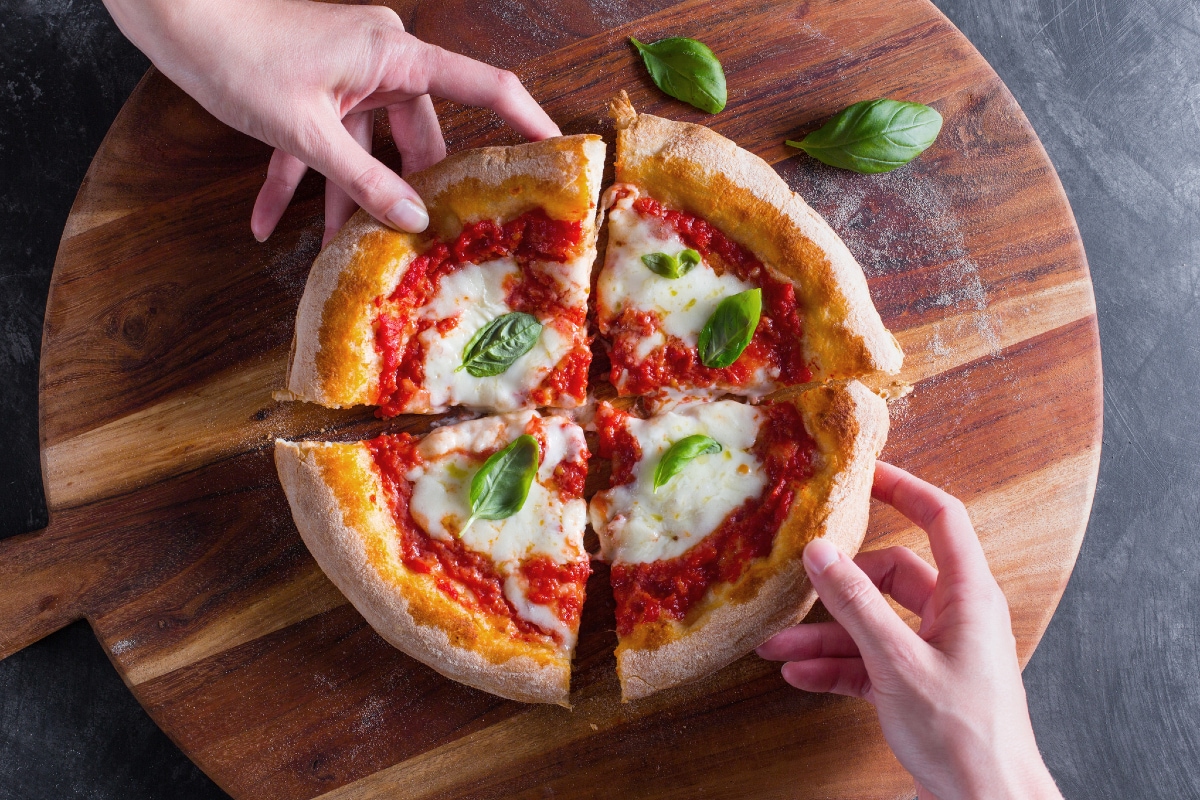Long Fermentation Pizza
- Average
- 1 h 25 min

Experience the simplicity and perfection of Pizza Margherita, the quintessential Italian dish that captures the heart of Naples. With its thin, crisp crust, vibrant tomato sauce, creamy mozzarella, and fragrant fresh basil, this pizza is a masterpiece of balance and flavor. A drizzle of olive oil ties it all together, creating a dish that’s as delicious as it is iconic.
Legend has it that Pizza Margherita was created in 1889 to honor Queen Margherita of Savoy, with its red tomatoes, white mozzarella, and green basil representing the Italian flag. Today, this timeless classic remains a favorite worldwide, celebrated for its fresh ingredients and authentic taste.
Perfect for any occasion, Pizza Margherita is versatile and easy to make at home.
Follow our authentic recipe to recreate the flavors of a true Neapolitan pizzeria in your own kitchen and discover why Pizza Margherita is the crown jewel of Italian cuisine!
If you love pizza you can't miss these recipes:
Discover more delicious Pizza recipes and elevate your cooking game!

To make the pizza dough, we’ve chosen to knead by hand, but if you prefer to use a mixer or kneading machine, you can follow the same steps, using the dough hook at low medium speed. First of all, pour the two flours into a bowl 1, crumble the yeast into it 2, and pour in the water a little at a time 3. The ideal water temperature is 77°F (25°C).

As you pour the water in, stir slowly using a wooden spoon 4, and once you’ve added nearly all the water, add the salt as well 5. Continue adding the water and begin to knead with your hands to combine the ingredients well 6.

Finally, transfer the dough to a work surface and work it with your hands until it is smooth and even 7. At this point, leave it to rest on the work surface for around 10 minutes, covering it with a bowl 8. Once rested, give it a little fold: Imagine that the ball of dough is divided into 4 parts; take the end of each part, pull it out delicately, and fold it in toward the center 9.

After making the 4 folds, shape the dough into a ball again by turning it over on itself 10. Transfer the ball of dough into a bowl 11, cover with plastic wrap 12, and leave it to rise. For your convenience, you can place the bowl in an oven that’s turned off but with the light on; that way, the inside will reach a temperature of 79-82°F (26-28°C), which is ideal for leavening. Otherwise, you can put the bowl in a warm place. The leavening times are approximate because the dough itself, temperature, and weather conditions all have an influence on the leavening: On average, it should take 6 hours for the dough to double its volume.

After this leavening time has passed, the dough will be nice and puffed up 13, so transfer it to the work surface and divide it into three 9½-oz (365-g) pieces using a dough cutter 14. If needed, you can lightly flour the work surface. Next, take each portion of dough and lift up one end of it and bring it toward the center, like you did before in step 9. Repeat this process for the other 3 ends of the dough 15.

Turn the dough over and carry on with the rounding: Rounding the dough means turning it around with your hands on the work surface, bringing it toward you and then moving it away repeatedly until you get a smooth, even ball 16. As you form these little balls, transfer them to a greased pizza dough container 17 and cover with the lid 18.

Let the balls of dough rise for another 30 minutes 19. In the meantime, place the pizza stone in the upper part of the oven. Turn the oven on and heat to 480°F (250°C) in conventional mode. Now, using a dough cutter, carefully lift the first ball 20 out of the dough container. Transfer it to a work surface with plenty of semolina and also add some semolina to the surface of the dough. Press down in the middle of the ball using your fingertips 21.

Keep doing this, with a rotating movement, so the dough gets stretched out 22. Be sure not to press the edges down, however, and continue pressing and rotating until you get an 11-inch (28-cm) disc 23. Transfer the dough to a pizza peel, taking care not to damage it 24.

Now, using a spoon to help you, spread some tomato purée on the dough, leaving some room around the edge 25. Place the raw pizza in the oven by sliding it carefully onto the stone. Let it cook for around 6 minutes. In the meantime, cut the mozzarella into strips 26 or pull it apart with your hands. You can squeeze it out gently so that it doesn’t release too much water when it gets cooked. After 6 minutes have passed, take the pizza out of the oven using the peel 27.

Arrange the pieces of mozzarella on top 28 and then put it back in the oven for another 6 minutes, approximately. Once it’s nice and golden, take it out of the oven, add the basil leaves 29, and a drizzle of oil if you like, and serve up your Margherita pizza 30. Finish the other two pizzas following the same steps and enjoy while still hot.